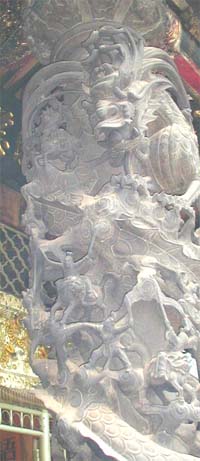|
Ancient Chinese
legend abounds with stories of dragons flying up to heaven. The story
behind the coiled dragons found on dragon pillars, apparently, is that
they are there because they haveníŽt yet ascended to heaven. |
|
|
Early period: This period includes columns made any time prior to about the middle of the Qing dynasty, i.e., before the mid to late 18th century. It was one dragon per column. The columns were generally comparatively thin and the carving simple. Early-middle period: In the middle years of the Qing dynasty the dragons were still carved in relatively low relief, but sculptors had begun by this time to carve the dragonsíŽ claws in the round, extended free of the pillar itself. The body had also become more sharply contorted by this time as well. Early-modern
period: By
the late 19th or early 20th century temple builders were using columns
with an octagonal cross section. A column fashioned in this period will
have one dragon on it, and is very likely to be decorated with carvings
of cloud patterns, floral patterns, and human figures. Modern period: Dragon pillars became increasingly ornate after Taiwan came under Japanese colonial rule in 1895, with Greek-style capitals, shafts twice as thick as in earlier years, and a surfeit of little details. |
|
